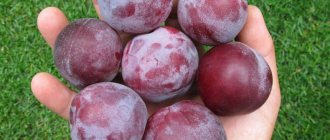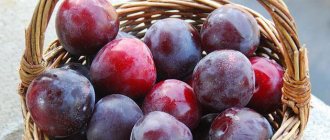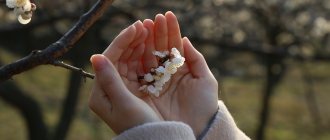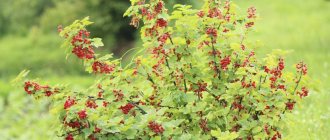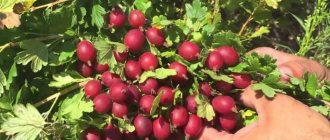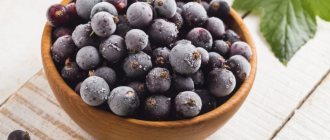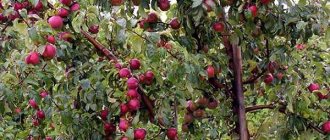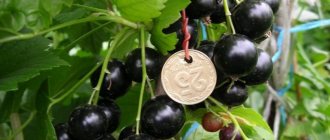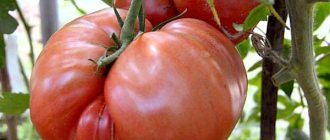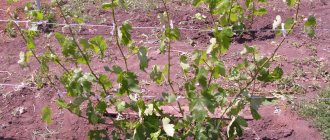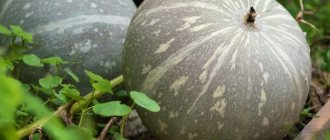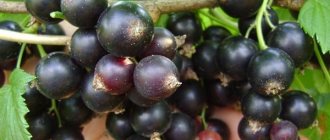Description of plum variety Nika
The variety is widespread today in several areas:
- north of Rostovskaya;
- south of Belgorodskaya;
- south of Voronezh.
Plum is characterized by average growth - up to 3 m. An adult plant after 15 years of life can reach 4 m. The rough bark is dark gray in color. Plum shoots change color: pinkish-brown in the sun, dark green in the shade.
Attention! With age, longitudinal cracks appear on the shoots, which creates a striped effect. This is a distinctive feature of the variety.
Wide, oval-shaped crown of medium density. Green leaves with deep veins are from 6 to 10 cm in length. Medium-sized flowers turn into fairly large oval-shaped fruits. Their weight ranges from 30 to 40 g. When ripe, the plum skin is light green. Ripe fruits of a dark purple hue. Their flesh is rich yellow. An overripe fruit becomes very juicy and soft. The taste of plums is sweet, with a slight sourness and a slight hint of tartness.
Growing Nika plum
Dark purple Nika plum appeared several years ago, but is actively gaining its place in the world market.
Due to its high taste, more and more gardeners prefer it. The advantages of the culture include resistance to frost and good immunity. This variety of plum was bred in Russia by breeder A. Voronchikhina. To obtain this high-quality plum variety, hybrid varieties with high levels of resistance to climatic conditions were used. In 2005, the Nika plum variety was included in the State Register of the Russian Federation.
It is ideal for planting in the central regions, but gardeners from the northern regions also plant it in their garden plots.
Advice
The description of Nick's plum indicates that it is self-sterile. If bees and other insects, due to weather conditions, do not fly and do not spread pollen, then you should not expect a large harvest. To improve productivity, it is better to plant pollinators nearby - plum varieties Voronezhskaya, Pavlovskaya or Chinese.
Frost resistance is one of the advantages of this crop. It successfully survives temperatures of -30 °C without loss of yield. The ripening time of plums of this variety is average, i.e., harvesting occurs at the end of July.
Mature plants can reach a height of 5 m. The crown is wide, pyramidal in shape. The main color of the bark is light gray. The bark quickly delaminates and cracks in the vertical direction. The shoots of the tree are presented in the form of nodes, and their color varies from burgundy to dark brown. The buds are cone-shaped, medium in size.
The inflorescences are white, shaped like a cup. The leaf blade is large, dark green in color. There is a dense layer of wax coating on its surface.
Features of the fetus
From the description of Nika's plum, the following fetal indicators are noted:
- berries are large, average weight 30 g;
- oval shape;
- the peel is characterized by high density and a dark purple hue;
- there is a dense layer of waxy coating, which is presented in a blue tint.
The pulp is juicy, fibrous, soft. The taste is pleasant, sweet, with slight notes of acid. There is a slight tartness. The stone is small and easily separated from the pulp. Universal products.
Planting of plum variety Nika should be carried out in well-moistened soils. The maximum depth of groundwater should be 2 m. This will allow the roots to independently absorb moisture if there is insufficient watering.
The planting site should be well illuminated by the sun's rays, but also protected from the wind, so planting is carried out from the southern part of the garden, not far from the fences. They will serve as protection from drafts and wind.
The planting hole needs to be prepared in the fall. To begin, loosen the soil throughout the entire area and add 10 kg of humus for every 1 square meter. m. After this, dig a hole. Its dimensions should be 80x70 cm. 5 kg of humus is poured into the hole and the fertilizer is allowed to absorb for 20 days. At this time, they begin to select a seedling according to the following criteria:
- age - 1.5-2 years;
- height - up to 100 cm;
- absence of diseases and injuries;
- developed roots;
- grafting with cuttings.
The seedling should be stored until spring in the ground covered with snow. In the spring, on the day of planting, it is placed in the hole. The roots are tightly covered with soil, leaving the root collar above the soil surface. Air will be supplied through it to the root system. The next day, you need to water the young plant with 10 liters of warm water and mulch the tree trunk circle with humus and straw.
Rules of care
Caring for the Nika plum variety involves fertilizing, loosening the soil, watering and removing weeds. It is necessary to loosen the soil and remove weeds after watering. Irrigation is carried out at intervals of 20 days for young plants and 30 days for mature trees. For 1 young tree, 20 liters of warm water should be used, and for an adult, the optimal option is 60 liters of warm water.
Feeding involves the use of mineral components.
- In the spring, water with 20 liters of ammonium nitrate solution (30 g per 5 liters of water). This will speed up the process of ovary formation and help form large fruits.
- To protect the plant from frost in the fall, water with 30 liters of superphosphate solution (60 g per 10 liters of water).
Read more: Hybrid of cherry and bird cherry cerapadus varieties with currants
If diseased or damaged areas are found, pruning is required. It is not necessary to trim the crown, since the tree’s growth is already low. All cut points must be treated with garden varnish to prevent bacteria and viruses from entering the tree.
The main diseases that occur on Nika plums include powdery mildew, olive spot, fruit rot and hole spot.
- Spraying with a manganese solution (30 g per 10 liters of water) will help get rid of fruit rot.
- Against olive spot, it is better to use Acyclovir (40 g per 5 liters of water).
- In the fight against powdery mildew, Bordeaux mixture (50 g per 10 liters of water) comes to the rescue.
- A solution of colloidal salt (70 g per 8 liters of water) helps against perforated spotting.
Treatments against diseases are carried out at intervals of 15 days.
Plum of this variety is often affected by aphids, codling moths and flea beetles. Pests must be controlled using chemicals. The copper-containing drug “Oxychom” (30 g per 5 liters of water) is used against aphids.
It is better to use the Khomus solution against fleas (50 g per 7 liters of water). Copper sulfate (20 g per 6 liters of water) helps prevent codling moths. It is also used for prevention.
https://www.youtube.com/watch?v=2MPIJpXzbJc
Spraying against pests is carried out once a month.
Conclusion
Nika gained its initial popularity thanks to the taste of its fruits. If you follow all the recommendations for planting and care, then even a beginner will be able to grow high-quality products. The fruits can be used both for fresh consumption and for preparing freshly squeezed juices or compotes.
The place where the tree is planted must meet certain conditions:
- the sun should penetrate to it unhindered throughout the daylight hours;
- it should not be blown by cold wind;
- groundwater should not be closer than 1.5 m;
- the ground should freely allow moisture and air to pass through; it is preferable to choose loam with a neutral reaction.
It is advisable to plant in the spring, but in the southern regions it can be done in the fall. A hole up to 50 cm deep should be dug in advance and humus should be added to the soil. For support, the seedling can be secured to a peg. The soil must be compacted, watered and mulched.
The Nika plum variety is not yet widespread, but every year it is gaining more and more popularity due to the excellent taste characteristics of the fruit.
They can be consumed fresh or used to make jams, preserves and juice with pulp.
The Nika variety is characterized by medium-sized and sometimes vigorous trees. By the age of fifteen they can reach four meters in height. The tree has a wide-oval spreading crown of medium density. The color of the bark on the trunk can be dark gray or gray-black.
The bark is characterized by strong roughness and the presence of medium or strong longitudinal cracking. The curliness of the trunk is very weakly expressed or not expressed at all. The tree produces knotty shoots, which at a young age are capable of changing their color depending on the light.
In the sun they have a pinkish-brown color, and in the shade they turn light green. A little later, the shoots acquire a brown-black color. Longitudinal yellow-brown cracks appear on them, and the shoots look striped. This is precisely the characteristic feature of the Nika variety.
Vegetative buds are cone-shaped and medium in size, while generative buds are small and ovoid in shape.
The leaf blade is characterized by an elongated oval shape with a pointed tip. Its base can be either wedge-shaped or arched.
The length of the leaf blade is usually six to ten centimeters long and four to six centimeters wide.
The leaf blade has a leathery consistency. Above it is green, smooth and shiny, and below it is light gray-green and pubescent along the veins.
The leaf blade is distinguished by double-toothed edges and medium serration.
The tree of this variety is characterized by small petioles with a pair of small glands and the absence of stipules, having a dirty burgundy anthocyanin color. The inflorescence most often consists of two flowers, but may have one or three flowers.
The flowers are medium in size and cup-shaped. They are characterized by closed, corrugated, rounded petals. The length of the stamens is from five to seven millimeters, and the pistil with ovary is from ten to twelve millimeters.
The Nika plum variety is distinguished by rather large oval-shaped fruits, the weight of which ranges from thirty to forty grams, but with a small harvest it can be a little more. The fruits are characterized by unequal sidedness in relation to the abdominal suture and an almost complete absence of flattening on the sides.
Read more: High temperature in a dog, reasons, how to help? What is a dog's normal body temperature?
The fruits have a rounded top, in the middle of which there is a small depression, an oval base and a shallow funnel. The abdominal suture is weakly developed and does not crack. In appearance, the fruits of the Nika plum variety resemble Hungarian plums.
Initially, the fruits have a green skin, which when ripe becomes dark purple with a thick coating of blue. The pulp is yellow-green in color, and when fully ripe it becomes brown-yellow.
The fruits are characterized by a dense consistency, and when overripe they become soft and very juicy. They are characterized by a sweet taste with a slight sourness and a slight hint of astringency. According to the tasting scale, plum fruits of the Nika variety are rated at 4.3 points. The fruits are distinguished by a long stalk and a small stone of an elongated oval shape.
The plum variety Nika was bred at the Rossoshansky zonal experimental horticultural station. It was received by A.Ya. Voronchikhin by crossing hybrid forms. In 1994, this variety was included in the register and allowed for cultivation in the Central Black Earth region.
Currently, it is quite poorly distributed and is grown mainly in home gardens in the north of the Rostov region, as well as in the south of the Belgorod and Voronezh regions.
Characteristics of the variety
This variety has distinctive features that determine the nuances of planting and caring for the plant. The abundance of the harvest and the health of the planting depend on taking into account the personal characteristics of the Nika plum variety.
Drought resistance, frost resistance
The plum tree tolerates drought and frost without damage. The Nika variety can withstand the hot season provided that the soil is regularly moistened. Resistance to significant temperature changes allows the plant to be planted in the northern regions of the country.
Pollinators of Nika plum
The Nika variety is self-sterile.
Attention! The best pollinators for it are considered to be: Hungarian Donetskaya, Renklod Sovetsky.
Plum blossoms in the middle of the warm period. For a bountiful harvest, the plant needs good weather during this period. Poor climatic conditions prevent insect migration and quality pollination. The fruits ripen by August.
Productivity, fruiting
Five to six years after planting, the plum will produce its first harvest. It is characterized by high precociousness. From one tree you can collect up to 35 kg of fruit. With proper care and good pollination, the yield can be doubled.
Area of application of berries
Most often, Nika plum fruits are consumed fresh. An excellent option for using fruits is preserves and jams. In compotes, the fruit becomes soggy.
Important! Nika plum tolerates transportation well over long distances.
Resistance to diseases and pests
One of the advantages of the Nika variety is its high resistance to all types of diseases. Throughout history, scientists have not recorded cases of mass destruction by known diseases or pests. Timely prevention methods prevent their occurrence and development.
Advantages and disadvantages of the variety
The advantages of plum make it stand out compared to other garden crops:
- Frost resistance. Can be planted in northern regions. Temperature changes will not harm the plant.
- Abundant harvest. The plum bears many fruits in one season. Under favorable conditions and good care, the amount of fruit from one tree can be doubled.
- Unpretentiousness. The variety will not require large time or material costs.
A specific feature of Nika plum is the instability of the harvest. Under unfavorable climatic conditions, pollination will be worse - the number of fruits will be significantly reduced. The situation can easily be corrected by pollinating varieties planted nearby.
Features of culture
Although the “Nika” variety was initially recommended for planting in the Central Black Earth region, now it is much more widespread throughout Russia - its features allow:
- withstands droughts without damage;
- has good winter tolerance, but the buds are not very frost-resistant;
- It is extremely resistant to diseases - over the years of observation it has never been affected by moniliosis and clasterosporiasis, and rarely suffered from polystigmosis.
The tree prefers sunlight and produces better yields when sheltered from the wind. Almost the only, but solvable, drawback is the irregularity of fruiting, which is overcome by artificial pollination.
Landing Features
Nick's plum is planted in a garden plot for several decades. Planting a tree is a responsible undertaking. It is important to take into account the characteristics of the variety, choose the right place and soil. If you follow all the recommendations, the plant will delight you with rapid growth and a bountiful harvest.
Recommended timing
The best time for planting is spring. During the warm season, the young plant will have time to take root and get used to the climate and planting site. If seedlings were purchased in the fall, then during the winter they should be buried in the ground and carefully covered.
Choosing a suitable location
Nika plum prefers sunny places, protected from drafts and winds. The soil for planting must be moisture-absorbing. It is worth checking the groundwater level. They should not be higher than 2 m to the seedling hole.
Important! The variety must be planted on the south side of tall neighboring trees. The plant does not like shade.
What crops can and cannot be planted nearby?
Pollinating varieties are located next to the Nika plum. They have a beneficial effect on productivity. Apple trees and shrubs will be good neighbors for this variety. Tall plants with spreading crowns will provide shade. This will negatively affect the growth and development of the plum. Such proximity should be avoided.
Selection and preparation of planting material
Planting material for planting seedlings of the Nika variety must be prepared in advance:
- Shovel for holes.
- Device for loosening.
- Fertilizer.
- A stake for fixing the cutting.
- Elastic rope for gartering plants.
- Water.
Landing algorithm
Planting Nika plum is not a labor-intensive process. There are several required steps:
- Preparing the pit. Holes for seedlings are formed in a few weeks or in the fall. Depth - from 45 to 50 cm, diameter - from 60 to 70 cm. If you plan to plant several cuttings, then the holes for them are placed at a distance of at least 3 m from each other.
- Working with soil. The fertile layer of soil from the holes is mixed with fertilizers.
- Fixation of the plant. A stake is driven into the center of the hole. The seedling is lowered into the hole. Its roots should be 5 cm from the bottom. Sprinkle the plum with prepared soil and compact it. The plant is tied to a peg with a soft rope.
- Watering. For the first watering, two or three buckets of clean water are enough.
- Mulching the soil.
Characteristics
Plum trees of the Nika variety bloom in the middle period. This variety is self-sterile, so if during flowering weather conditions are not favorable for insect migration, the harvest may be completely insignificant.
The most suitable pollinators for plum variety Nika are: early Hungarian Donetsk, Renklod Soviet and Hungarian Donetsk.
Plum trees of the Nika variety begin to bear fruit in the fourth or fifth year and are distinguished by good early fruiting. The fruits ripen by August. The yield is quite high - up to thirty-five kilograms of fruit can be harvested from one tree, but cases have been recorded when the harvest was twice as high as this figure.
Such trees tolerate winter well, but the flower buds have weaker frost resistance. Plum fruits of the Nika variety are characterized by good transportability and excellent separation of the stone from the pulp.
Aftercare for plums
Caring for a young plant after planting is an important process. There are various recommendations for watering, fertilizing, and pruning plum trees. Advice from experienced gardeners is easy to follow:
- Watering. Nika plum is a moisture-loving variety. It will tolerate drought well if it is moistened in a timely manner. June, July, and the end of September are favorable months for watering using the “under the root” technique.
- Fertilizer. Plum prefers magnesium fertilizing. It should be added during the autumn digging of the garden. In spring, plantings are fertilized with nitrogen preparations.
- Trimming. To form the crown, numerous young shoots are shortened, which appear on the tree 2-3 years after planting.
- Fighting diseases and pests. To prevent the adverse effects of diseases, special means should be used to spray the plant.
- Preparing for winter. Before the onset of cold weather, the tree trunk is covered with burlap.
Advice! To protect the plant from pests, it is necessary to remove weeds around the tree trunk more than four times a season.
Diseases and pests, methods of control and prevention
| Disease/pest | Method struggle | Prevention |
| Moniliosis | Spraying a tree with Bordeaux mixture | Timely pruning of branches, removal of weeds. Affected shoots must be immediately destroyed |
| Plum moth | The use of special pheromone traps. They lure insects, saving the plum from their harmful influence. | Regular insecticidal spraying. During the warm season it is carried out at least twice. In May - the first treatment. 30 days before harvest - second |
Varietal characteristics
The place where the Nika variety appeared is the Rossoshansk experimental breeding station. It was developed by pollinating the Renklod variety. In the mid-90s. the variety became zoned for the Central Black Earth region. Drainage is most widespread in certain areas:
- Voronezh region;
- Belgorod region;
- Kursk region;
- Lipetsk region;
- partly in the Rostov region.
In these regions, Nika grows extremely successfully, exhibiting properties typical for the variety. The tree has an average height; in adulthood it can stretch up to 4 m. The spreading crown is not distinguished by dense foliage. The gray bark is rough to the touch and prone to cracking.
The color of the uneven shoots, which are partially pubescent, varies depending on climatic conditions. The appearance of stripes on the shoots is a distinctive feature of this plum. The swelling buds take on different shapes:
- ovoid;
- cone-shaped.
The shape of the leaf blades also varies from oval to ovoid with a sharp edge, the greatest length is 10 cm. The outer side of the plate is smooth, the inner side is veiny. There are small petioles without stipules.
The round petals of the flowers are united into cups, the diameter of which reaches 30 mm. Among the stamens one can see a tall pistil, a peduncle from 15 to 20 mm.
Nika plum: variety description, characteristics, planting, care and photos
- Varietal characteristics
- Growing
- Care
For Russian gardens, breeders have specially bred several varieties that, due to their characteristics, do not cause trouble to owners of personal plots. Among them, the Nika plum stands out. Trees of this variety do not bear fruit every year, but they produce more than 30 kg of fruit per season, starting 4 years after planting.
Gives a good harvest with a small fruit size
Description of the plum variety Startovaya
The plum variety Startovaya is the result of breeding work by scientists at the All-Russian Research Institute of Genetics and Selection of Fruit Plants named after I.V. Michurin, placed in the State Register in 2006. Parent trees are plums Volzhskaya krasavitsa and Eurasia 21.
Territories of distribution of the variety:
- Chernozem region of the Russian Federation;
- Ukraine;
- Moldova;
- Republic of Belarus;
- Georgia;
- Estonia.
It grows well in countries with a temperate continental climate, where winters are mild.
Did you know? Plum fruits contain a large amount of vitamin P, which lowers blood pressure and strengthens the walls of blood vessels. It is noteworthy that it is practically not subject to destruction during fruit processing.
The starter plum is distinguished by large, round fruits with an oval top and an elongated base, the average weight of which is 45–50 g, with a hard burgundy skin with a purple tint. No subcutaneous freckles. The fruit separates well from the stalk, but does not fall off. The fruit pulp is amber in color, highly juicy, and has a sweet and sour taste.
Starter plum trees have a spreading crown and an abundance of leaves (small in size, with pointed edges and an uneven surface). Stipules fall off early. The branches are curved, wide, burgundy in color with a silvery coating.
The petioles are slightly pigmented. The glands are amber-colored, located two on each petiole. The flowers are large, bright white, the calyx is bell-shaped, and the anthers of the flower are located below the stigma.
Did you know? Not only the fruits, but also the leaves of the plum tree are used as medicinal raw materials in folk medicine. Once crushed, they are used as a healing agent for skin lesions.
Plum Nika
Nika's home plum is not a very common species these days, but thanks to the excellent quality of the fruit, everything will soon change. This variety is known for its large, juicy and sweet plums. They took him out to the Rossoshanskaya gardening station.
The home plum Nika has a medium or large tree, reaches a height of more than four and a half meters at the age of fifteen years, the crown is broadly oval, spreading, the bark is dark gray or black-gray.
By the way, this variety is easy to identify by its curved shoots - they have a funny striped color, the color of which changes from brownish-pink to light green, depending on the lighting.
The fruits are quite large, have an elongated oval shape, dense dark purple skin, with a waxy coating, and juicy golden flesh.
Plums weigh on average from thirty to forty grams. Usually Nika plum is always juicy, very sweet in taste, with a slight hint of sourness and barely noticeable tartness. It is easy to remove the pit from the pulp.
Absolutely all fruits have high taste qualities, they are very tasty and healthy. In general, this variety is consumed fresh. You should not make preserves from this plum, as the fruits will turn sour.
However, they make wonderful jams and juices with pulp.
For planting, choose a place with a groundwater level of no more than two meters; moisture-absorbing soil is preferable. This plum variety is self-sterile. The plum tree begins to bloom in early May.
You should know that if during flowering the weather is bad and there are no insects that carry pollen, as well as pollinators, then there may be no harvest at all or a small amount. Pollinated by the varieties Hungarian Donetskaya, Hungarian Early and Renklod Soviet. This species has good precociousness. Trees bear fruit in the fourth or fifth year.
The harvest is harvested in August; with good fruiting, in the first four years you can get eighteen kg of plums from a tree, and in a full seven years, about twenty-three kg of plums are collected from one tree. The species is very winter-hardy and will not suffer from heat and drought, which is a big plus. This variety is also resistant to fungal diseases.
Most likely, you will not encounter moniliosis or clasterosporiosis. Advantages of the variety: the fruits of this variety are of high quality and have decent winter hardiness. Disadvantages of the variety: it does not always bear fruit regularly.
When purchasing from our garden center, consultants will provide complete information on planting and caring for seedlings. If boarding yourself is difficult, you can order a boarding service from us.
Homemade Nika plums are sold on our website. Call the manager or send an order by email.
Source: https://kopsa.ru/ogorod/sliva-dashenka-otzyvy.html
